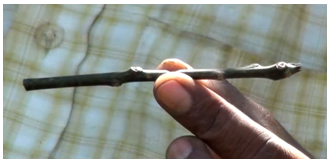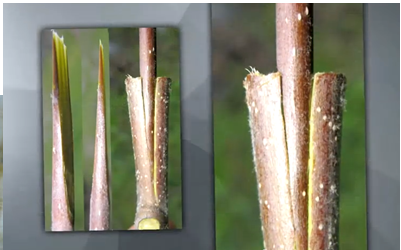| Mango |
Propagation
- Mango can be raised from seed or propagated vegetatively.
- Several methods of vegetative propagation have been tried with varying degrees of success.
- Propagation from seed, though easy and cheap, is unable to perpetuate characters of the parent tree because most commercial varieties in India are cross-pollinated and monoembryonic.
- Plants also take more time to bear fruit. However, it is essential to raise seedlings to be used as rootstocks.
|
| Soft-Wood Grafting |
- This method of grafting is done when the rootstock is overgrown and thus not suitable for stone grafting
- Normally in this method, seedlings of 8-10 months old are selected.
- The grafting is done on newly emerged flush. The scion wood to be used is defoliated 10 days prior to the grafting and has same thickness as that of terminal shoot.
- The method of grafting is similar to stone grafting. July and August are the best months for soft-wood grafting.
- The method of grafting is similar to stone grafting. July and August are the best months for soft-wood grafting.
|
| Inarching |
- The method of inarching or approach grafting is quite cumbersome and time consuming, but it is still the leading method for commercial propagation of mango plants
- The method consists of uniting the selected shoot (scion) of a desired parent tree (mother plant) with the potted or transplanted seedling (rootstock) by approach grafting.
- For this purpose, about one-year-old seedlings are most suitable when they attain a height of about 30-45 cm and thickness ranging from 0.75 to 1.5 cm.
- These seedlings are either grown in pots or under the mother plant from which the grafts are to be prepared.
- Generally, one-year-old twigs of the scion tree about 60 cm in length and nearly of the same thickness as that of the stock is chosen for grafting.
- Young and non-bearing trees should not be selected as mother plants.
- A thin slice of bark and wood, about 5 cm in length, 7.5 mm width and 2 mm deep, is removed by means of a sharp grafting knife from the stem of the stock as well as from the scion branch.
- The cuts thus made should be absolutely flat, clean, boat shaped, even and smooth.
- The ends of these cuts should be round and not angular.
|
- The cut surfaces of both, i.e., stock and scion are made to coincide facing each other so that there remains no hollow space between the two.
- Polythene/alkathene strips of about 1.5 cm in width are tied around the union.
- After about one month of operation, the scion below the graft union and stock above the graft union should be given light "V" shape cuts at weekly interval in such a way that the grafts can finally be detached while giving the fourth cut.
- In the last stage, the top of the stock above graft union should also be removed completely.
- Inarching should be done during the active growth period.
- The end of the monsoon in heavy rainfall areas and early monsoons in the light rainfall areas is the best period for inarching
|

|
| Veneer Grafting |
- This method of propagation possesses promise for mass scale commercial propagation.
- The method is simple and can be adopted with success.
- The rootstocks as mentioned for inarching are suitable for this method also.
- For conducting this grafting operation, a downward and inward 30-40 mm long cut is made in the smooth area of the stock at a height of about 20 cm.
- At the base of cut, a small shorter cut is given to intersect the first so as to remove the piece of wood and bark.
- The scion stick is given a long slanting cut on one side and a small short cut on the other so as to match the cuts of the stock.
- The scion is inserted in the stock so that the cambium layers comes on the longer side.
|

|
- The graft union is then tied with polythene strip as recommended for inarching
- After the scion remains green for more than 10 days, the rootstock should be clipped in stages.
- The scion wood to be used for veneer grafting requires proper preparation.
- The desired shoots should be defoliated at least one week prior to grafting so that the dormant buds in the axil of leaves become swollen
|
| Stone Grafting |
- Stone/epicotyl grafting is a simple, cheap and quick method of mango propagation with a success rate of 75-80%.
- For this purpose, stones should be sown in June-July on raised beds of size 1x3 m.
- The beds should e prepared by mixing soil and FYM in the proportion of 2:1.
- After germination, seedlings with tender stems having coppery leaves are lifted with stones still attached.
- The roots and stones are dipped in O.1 per cent Carbendazirn solution for 5 minutes after washing the soil.
- The seedling stems are headed back leaving 6-8 cm long stem.
- A 4-6 cm longitudinal cut is made running down through the middle of the stem.
- A wedge shaped cut starting on both sides is made on the lower part of scion stick.
- The scion stick should be 4-5 months old and 10-15 cm long containing plumpy terminal buds.
- The scion stick is then inserted in the cleft of the seedlings and tied with polythene strips.
- The grafts are then planted in polyethylene bags containing potting mixture.
- The bags are then kept in the shade protecting from heavy rain.
- The scion stars sprouting 15-20 days after grafting.
- Care should be taken to remove the sprouts on the rootstocks below the graft union during this period.
- July is the most suitable month for stone grafting
|
 |
 |
Sowing stones in polybag |
Germinated stones |
|







